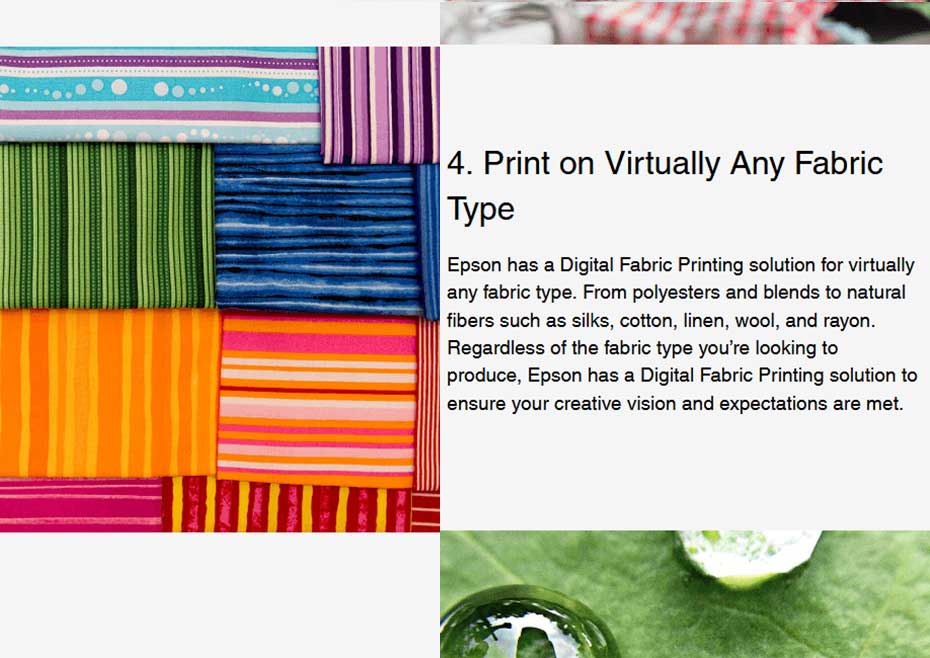Every apparel retailer should be familiar with three primary fabric types: cotton, polyester, and blended fabrics. In this blog post, we’ll be taking a closer look at each of them to help you decide which fabrics are the best for you.
Cotton – The #1 Choice of All Time
Cotton is the most widely produced natural fiber on the planet. As a fabric, it’s known for its comfort and durability, which makes it one of the most popular fabrics used in apparel.
Feel and wear
Cotton is a versatile fiber that can be woven or knitted into many different fabrics like denim, flannel, jersey, and more. Each of which, of course, has a slightly different feel and wear.
All cotton fabrics are soft and breathable, which makes them perfect for warm climates and hot weather, and for people with sensitive skin.
Lastly, cotton isn’t clingy. So if you don’t want to sell form-fitting clothes on your store and prefer a looser fit, choose cotton. But keep in mind 100% cotton dries slowly, so it’s probably not ideal for active wear.
Printing suitability
Cotton makes a great surface for DTG printing. So if you want your design to be opaque and crisp, pick a garment made from 100% cotton. Just keep in mind that DTG prints don’t come out as solidly on thick cotton clothing (e.g. sweatshirts) as they do on t-shirts.
Durability and care
High-quality cotton is super durable, which makes it less prone to accidental rips or tears. However, cotton isn’t as durable as polyester or cotton/polyester blends.
Just like most natural materials, it can shrink when subjected to high temperatures. So when washing a cotton shirt, use cold water and avoid adding too much detergent as doing so can affect the wear and tear of the material. Choose delicate cycle setting on your washing machine to prevent color fading.
Polyester
Polyester is a man-made fiber that is synthesized from petroleum-based products. Polyester cloth was invented in 1941, so comparing to cotton, this fabric is a fairly new player in the game.
But despite that, polyester is becoming an increasingly popular option in the apparel industry. Polyester is especially valued by those who are looking for a fabric that withstands a lot of wearing and washing.
Feel and wear
Polyester is lightweight and has a slightly silkier feel to it than cotton does. It’s also perfect for sports. Apparel made from polyester traps the sweat against the skin. This means that polyester shirts may feel slightly clammy in warm weather, but warm in cooler weather.
For those with extremely sensitive skin, polyester may cause a small irritation, but it isn’t as common when polyester is blended with other fabrics.
Printing suitability
For some time, printing on polyester was quite a challenge. But thanks to special dyes and advanced printing technologies, achieving high-quality prints on polyester fabrics is no longer a worry. Printed colors are vibrant and unlikely to fade with time.
However, since printing on polyester garments is more difficult than on cotton or fabric blends, polyester products are usually more expensive.
Durability and care
Polyester is very durable, more so than cotton and most blended fabrics. It’s also difficult to stain permanently because polyester is less absorbent than most fabrics.
Polyester fabrics are also known for their resistance to wrinkling, shrinking and fading when properly taken care of. That said, it’s recommended to machine wash polyester garments in warm water with all-purpose detergent, then follow up with tumble-dry at a low-temperature setting.
Fabric Blends
As you can probably guess, fabric blends are created when two or more different kinds of fibers are combined together to create a new type of textile with unique properties.
Throughout the years, blended fabrics have been developed to cater to specific needs, like improving the texture, durability, feel of the material, or even reducing the cost of apparel production.
Today there are hundreds of fabric blends available in the market, but the more popular blends for printed apparel are:
Polyester-spandex blends (85/15)
Spandex, also known as elastane or lycra, is a synthetic fiber best known for its elasticity. When combined with cotton, spandex makes a perfect fabric for clothing that is soft to touch and durable. Most commonly, polyester-spandex blends are used in activewear as spandex is stretchy and can retain its original shape, and polyester – durable.
Cotton-polyester blends (65/35 and 50/50)
The cotton-polyester blend is versatile and is used to make everything from bedding to shirts. Because polyester doesn’t shrink or change shape like cotton does, this blend is easier to wash and dry. And thanks to the cotton component in the blend, garments made from cotton-polyester are more breathable compared to pure polyester products.
Polyester-cotton-rayon blend (50/25/25)
Rayon is semi-synthetic fiber that combines just the right amount of polyester, cotton, and rayon. Apparel made from this fabric is soft and stretchy, yet durable. This famous tri-blend makes perfect fabric for loose fit apparel, and are loved for their snuggly feel.

Epson Digital Printing Solution Partners
— Print My Fashion


